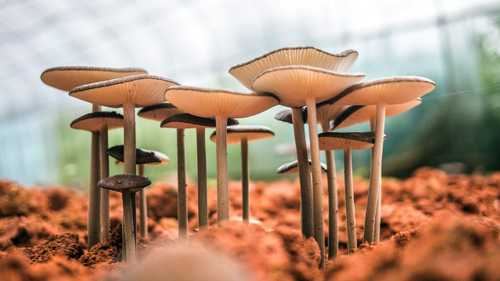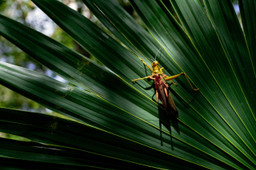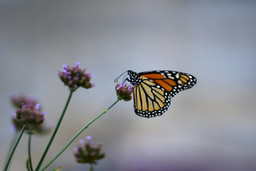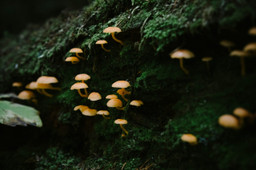
Making the inaudible audible: The unheard songs of trees, fruit, and insects
Just because we can’t hear something, that doesn’t mean it’s not producing sound. Case in point: the diverse seismic communication used by treehoppers, as recently seen in David Attenborough’s Secret World of Sound. In fact, there’s a whole sonic domain out there in the natural world which we simply haven’t historically been privy to. However, modern technology is increasingly allowing us to access it, from sounds produced by insects and plants to even fruit or fungi.
An insect cacophony
Of course we’re all aware of the sounds made by insects, from the buzzing of bees to the chirping of crickets and cicadas – but get closer and you may be amazed by the astonishing wealth of sonic variety present in the arthropod world. For example, a series of recordings by naturalist John Acorn, of the University of Alberta, gives a taste of the range of sounds that even familiar arthropods like crickets or grasshoppers can produce. (In an accompanying article, Acorn also provides invaluable recording tips such as the adaptation of a stainless steel salad bowl into an effective parabola.)
Meanwhile, sound designer, audio engineer, and composer Nicolas Titeux, who has produced two compilations of insect sounds – including bees, hissing cockroaches (which mimic the sounds of snakes), praying mantises, hawk moths, hoverflies, and shield bugs – has created a detailed guide about how to go about recording these kinds of ultrasonic sounds (ie, those above the upper limit of the human audible range).

Similarly, film sound effect library Pro Sound Effects offers a collection called Beautiful Bugs, which includes “rhythmic cicada swells, dense locust drones, mosquito cries, isolated fly buzzes and more” – many of which were recorded during the making of David Lynch’s Blue Velvet. Recordist, sound designer, and effects editor Ann Kroeber, who created the collection with her late partner, Alan Splet, has also spoken “about her experiences recording bugs across the world”, discussing techniques for recording arthropods with analog equipment, and the “musicality” of the “rhythms and moods that [arthropods] produce”.
An earlier compilation of insect recordings, 1960’s Sounds of Insects, by Albro T. Gaul, offers not only an explanatory narration, but encompasses a greater range of species, including hornets, May beetles, warble flies, long-horn beetles, katydids, butterflies, dragonflies, deer flies and spiders.
Today, recordists posting on social media build upon this existing work by continuing to bring the sonic world of the arthropods to life with recordings of ant communication and bullet ant nests, caterpillars squeaking or clicking to deter predators, or giant Malaysian katydids (a type of bush cricket which grows up to 6 inches [15 cm] in length and produces sound through stridulation).
Plant communication?
Sounds made by moss, bamboo moving in the wind, trees creaking and the insides of their trunks, recorded with contact microphones, have been disseminated on social media by users such as Charles Rose (AKA Chasseur de sons: “Sound Hunter”).
Even more extraordinary are the sounds which a 2023 study established that plants make when under stress. Plants have previously been noted to emit ultrasonic vibrations, but this is the first time that they have been observed producing airborne sound. In addition, these sounds alter according to their circumstances, for example, whether they have been damaged or require water.
So what do these botanical noises sound like? “A bit like bubble wrap being popped”, as it turns out. Or, at least, tomato plants do once they’ve been “down-sampled to the audible range, and the silent intervals between the […] sounds are compressed (by a factor of 200)”; listen here. While stressed plants may emit as many as 30 to 50 pops or clicks during an hour, this may reduce to as few as one per hour for unstressed plants. Species also found to produce sound include corn, wheat, grapevines, and cacti.
Though too high for human ears to hear when unprocessed, they may be audible to insects and mammals (say, mice and bats), and possibly even other plants; previous research has shown that “plants can respond to sounds and vibrations”, such as those made by pollinators. Although taking place on a frequency which made them inaudible to us, the sounds were nevertheless as loud as a human conversation and could be recorded up to 16 feet [5 m] away.

However, the reason for these noises is as yet unclear; it could be related to communication, or simply be “a byproduct of physiological processes”, for example, “due to air bubbles forming and bursting in the plant’s vascular system”. Either way, this discovery is a reminder that even in seemingly quiet situations, “there is the possibility that a lot of acoustic interaction is occurring”.
Plant ‘music’?
Another way of giving voice to seemingly silent biological specimens is through sonification. While this term can refer simply to the production of sound, it is also used to mean “the audible display of data”: ie, “the use of non-speech audio to convey information or perceptualize data”. Remarkably, this technique can even be used to create music from living beings.
Under the moniker of Modern Biology, former biologist Tarun Nayar uses ‘biodata sonification’ to make music; by hooking any living organism to a modular synth, he can transform its bioelectrical signals into electronic music. While this technique can be applied to people and animals, it’s trees, plants, fruit, and mushrooms that have attracted attention on TikTok. (The music of fellow TikTok user Noa Kalos, who goes by the name of MycoLyco, is, as you might expect, even more fungi-oriented.)

Nayar has produced three albums of “dreamy ambient soundscapes” made in this way, and though, as noted in a profile by the Los Angeles Times, “the mushrooms aren’t making the music themselves, or deliberately choosing which notes we hear”, the popularity of his output speaks to an appetite for engagement with the natural world at large, and specifically with that enigmatic non-plant, non-animal, the fungi. (Nayar is even currently touring parks in Europe with a show combining music, foraging, and clean-ups.)
The technology which enables Nayar and Kalos’ work is even available in various domestic versions. However, it would be disingenuous to suggest that PlantWave, Music of the Plants, MIDI Sprout, or PLANTChoir devices are allowing buyers to access a soundscape which is being actively produced by the plants they have been connected to. Rather, they monitor “microcurrent fluctuations occurring across the surface of a plant’s leaf”, then produce Musical Instrument Digital Interface (MIDI) notes when any change in this conductivity occurs. Therefore, by rendering these “changes over time […] as waves and translat[ing them] to pitch”, the devices create “an artistic expression of real data”.
So, though these devices aren’t playing music made by plants themselves, there is a case for “the accessible, universal language of music [to] bring everyday people closer to these mind-blowing organisms”. It can also be hoped that, in future, increased accuracy will allow biodata sonification to have an application within empirical research, perhaps allowing us to understand “what these electrical fluctuations say about fungal life”.
The “responsive generative music” of ‘plant speaker’ devices, and the extent to which raw data may be “heavily manipulate[d]” by artists “to make them more pleasing to the human ear”, could be accused of anthropomorphizing the organisms upon which the music is built. Yet, like all of these examples of unheard nature sounds, that their popularity promotes further engagement with the embattled natural world is unequivocally positive.
Featured photo by Phoenix Han on Unsplash
Earth.fm is a completely free streaming service of 1000+ nature sounds from around the world, offering natural soundscapes and guided meditations for people who wish to listen to nature, relax, and become more connected. Launched in 2022, Earth.fm is a non-profit and a 1% for the Planet Environmental Partner.
Check out our recordings of nature ambience from sound recordists and artists spanning the globe, our thematic playlists of immersive soundscapes and our Wind Is the Original Radio podcast.
You can join the Earth.fm family by signing up for our newsletter of weekly inspiration for your precious ears, or become a member to enjoy the extra Earth.fm features and goodies and support us on our mission.
Subscription fees contribute to growing our library of authentic nature sounds, research into topics like noise pollution and the connection between nature and mental wellbeing, as well as funding grants that support emerging nature sound recordists from underprivileged communities.

